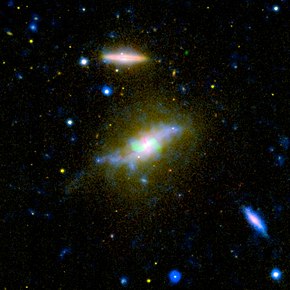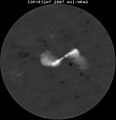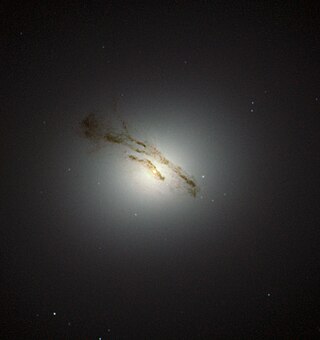
Messier 84 or M84, also known as NGC 4374, is a giant elliptical or lenticular galaxy in the constellation Virgo. Charles Messier discovered the object in 1781 in a systematic search for "nebulous objects" in the night sky. It is the 84th object in the Messier Catalogue and in the heavily populated core of the Virgo Cluster of galaxies, part of the local supercluster.

NGC 2787 is a barred lenticular galaxy approximately 24 million light-years away in the northern constellation of Ursa Major. It was discovered on December 3, 1788 by German-born astronomer William Herschel. J. L. E. Dreyer described it as, "bright, pretty large, a little extended 90°, much brighter middle, mottled but not resolved, very small (faint) star involved to the southeast". The visible galaxy has an angular size of 2.5 × 1.5 arcminutes or 3.24 × 1.81 arcminutes and an apparent visual magnitude of 11.8.
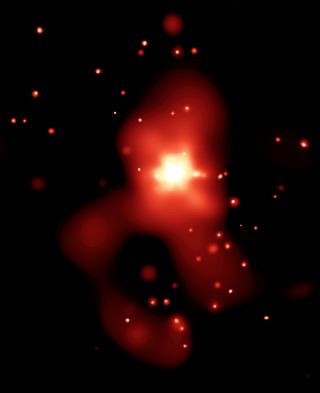
NGC 4261 is an elliptical galaxy located around 100 million light-years away in the constellation Virgo. It was discovered April 13, 1784, by the German-born astronomer William Herschel. The galaxy is a member of its own somewhat meager galaxy group known as the NGC 4261 group, which is part of the Virgo Cluster.

NGC 3862 is an elliptical galaxy located 300 million light-years away in the constellation Leo. Discovered by astronomer William Herschel on April 27, 1785, NGC 3862 is an outlying member of the Leo Cluster.

NGC 708 is an elliptical galaxy located 240 million light-years away in the constellation Andromeda and was discovered by astronomer William Herschel on September 21, 1786. It is classified as a cD galaxy and is the brightest member of Abell 262. NGC 708 is a weak FR I radio galaxy and is also classified as a type 2 Seyfert galaxy.
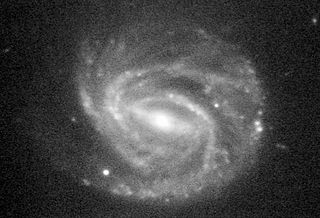
NGC 3367 is a barred spiral galaxy located in the constellation Leo. It is located at a distance of about 120 million light years from Earth, which, given its apparent dimensions, means that NGC 3367 is about 85,000 light years across. It was discovered by William Herschel on March 19, 1784.

NGC 541 is a lenticular galaxy located in the constellation Cetus. It is located at a distance of about 230 million light years from Earth, which, given its apparent dimensions, means that NGC 541 is about 130,000 light years across. It was discovered by Heinrich d'Arrest on October 30, 1864. It is a member of the Abell 194 galaxy cluster and is included in the Atlas of Peculiar Galaxies in the category galaxies with nearby fragments. NGC 541 is a radio galaxy of Fanaroff–Riley class I, also known as 3C 40A.

NGC 7130 is a spiral galaxy located in the constellation Piscis Austrinus. It is located at a distance of about 220 million light years from Earth, which, given its apparent dimensions, means that NGC 7130 is about 100,000 light years across. It was discovered by John Herschel on September 25, 1834, and discovered independently by Lewis Swift on September 17, 1897. The location of the galaxy given in the New General Catalogue was off by 30 arcminutes in declination from the location of the galaxy.

NGC 1386 is a spiral galaxy located in the constellation Eridanus. It is located at a distance of circa 53 million light years from Earth, which, given its apparent dimensions, means that NGC 1386 is about 50,000 light years across. It is a Seyfert galaxy, the only one in Fornax Cluster.

NGC 3665 is a lenticular galaxy located in the constellation Ursa Major. It is located at a distance of circa 85 million light-years from Earth, which, given its apparent dimensions, means that NGC 3665 is about 85,000 light years across. It was discovered by William Herschel on March 23, 1789.
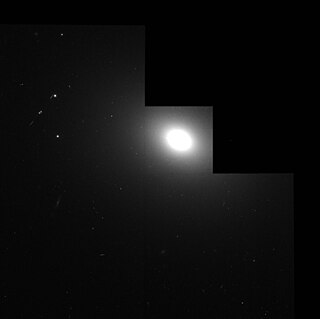
IC 1459 is an elliptical galaxy located in the constellation Grus. It is located at a distance of circa 85 million light-years from Earth, which, given its apparent dimensions, means that IC 1459 is about 130,000 light-years across. It was discovered by Edward Emerson Barnard in 1892.

NGC 4278 is an elliptical galaxy located in the constellation Coma Berenices. It is located at a distance of circa 55 million light years from Earth, which, given its apparent dimensions, means that NGC 4278 is about 65,000 light years across. It was discovered by William Herschel on March 13, 1785. NGC 4278 is part of the Herschel 400 Catalogue and can be found about one and 3/4 of a degree northwest of Gamma Comae Berenices even with a small telescope.

NGC 973 is a giant spiral galaxy located in the constellation Triangulum. It is located at a distance of circa 200 million light-years from Earth, which, given its apparent dimensions, means that NGC 973 is about 230,000 light years across. It was discovered by Lewis Swift on October 30, 1885.

NGC 545 is a lenticular galaxy located in the constellation Cetus. It is located at a distance of about 250 million light years from Earth, which, given its apparent dimensions, means that NGC 545 is about 180,000 light years across. It was discovered by William Herschel on October 1, 1785. It is a member of the Abell 194 galaxy cluster and is included along with NGC 547 in the Atlas of Peculiar Galaxies.

NGC 547 is an elliptical galaxy and radio galaxy located in the constellation Cetus. It is located at a distance of about 220 million light years from Earth, which, given its apparent dimensions, means that NGC 547 is about 120,000 light years across. It was discovered by William Herschel on October 1, 1785. It is a member of the Abell 194 galaxy cluster and is included along with NGC 547 in the Atlas of Peculiar Galaxies.

NGC 765 is an intermediate spiral galaxy located in the constellation Aries. It is located at a distance of circa 220 million light years from Earth, which, given its apparent dimensions, means that NGC 765 is about 195,000 light years across. It was discovered by Albert Marth on October 8, 1864. The galaxy has an extensive hydrogen (HI) disk with low surface brightness, whose diameter is estimated to be 240 kpc.

NGC 2273 is a barred spiral galaxy located in the constellation Lynx. It is located at a distance of circa 95 million light years from Earth, which, given its apparent dimensions, means that NGC 2273 is about 100,000 light years across. It was discovered by Nils Dunér on September 15, 1867.
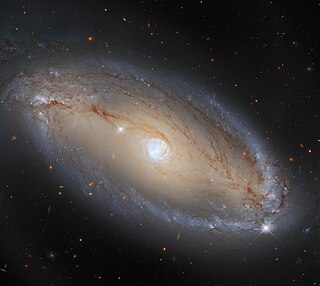
NGC 5728 is an active barred spiral galaxy located 146 million light years away in the southern constellation of Libra. It was discovered on May 7, 1787 by William Herschel. The designation comes from the New General Catalogue of J. L. E. Dreyer, published in 1888. It has an apparent visual magnitude of 13.40 and spans an angle of 3.4 arcminutes. The galaxy shows a red shift of 0.00935 and has a heliocentric radial velocity of 2,803 km/s. It has an estimated mass of 72 billion times the mass of the Sun and stretches around 30 kpc across.

NGC 7720 is an elliptical galaxy located in the constellation Pegasus. It is located at a distance of about 380 million light years from Earth, which, given its apparent dimensions, means that NGC 7720 is about 180,000 light years across. NGC 7720 is the main galaxy of Abell 2634 galaxy cluster and is a radio galaxy. It was discovered by William Herschel on September 10, 1784.

NGC 2911 is a peculiar lenticular galaxy in the constellation Leo. The galaxy lies about 145 million light years away from Earth, which means, given its apparent dimensions, that NGC 2911 is approximately 165,000 light years across. It was discovered by William Herschel on March 11, 1784.
